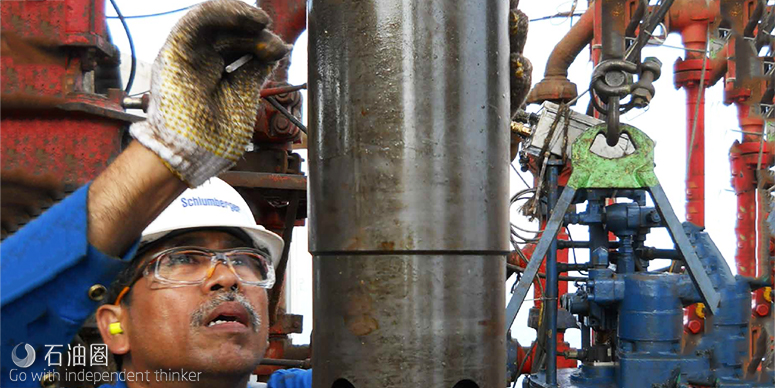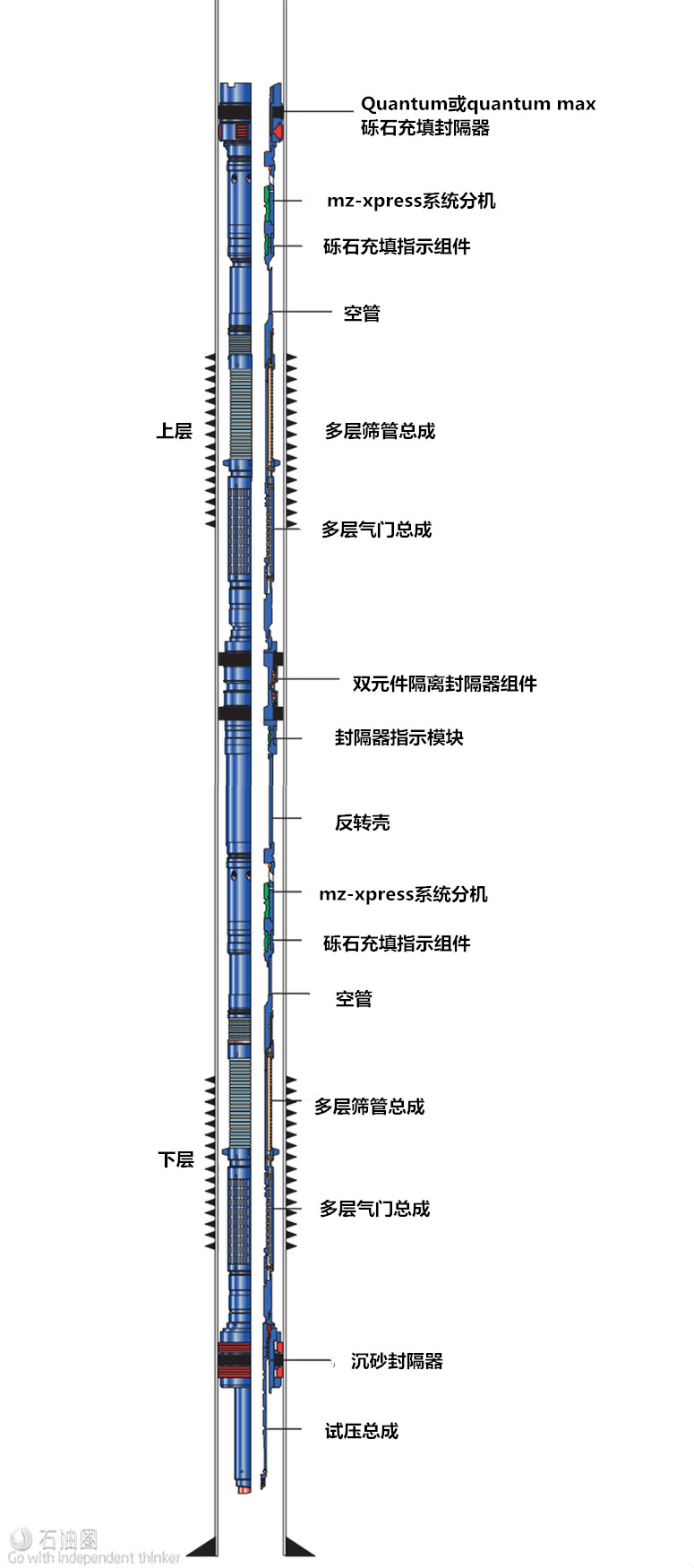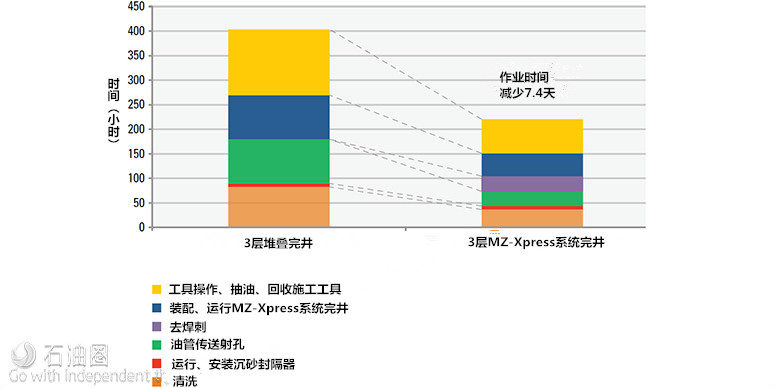MZ-Xpress Completion System
The MZ-Xpress* completion system performs multizone gravel and frac packing in a single trip. All zones of interest are perforated, and then the MZ-Xpress system hardware is deployed, set, and tested. Individual zones are gravel packed or frac packed from the bottom up. The MZ-Xpress system allows complete isolation of the zones not immediately being completed and can be used when interval lengths or zone spacings differ.
The MZ-Xpress system was designed to address from two to more than five zones. Reservoir pressure gradients, zone
length, spacing, and pumping treatment size limit the number of zones to be completed and vary depending on the wellbore size.
This MZ-Xpress single-trip system is suitable for low-tier and land wells, as well as the next generation of challenging wells, including those in deep water.
ApplicAtions
■Multizone completions
■Frac-packing operations
■Gravel-packing operations
■Land and offshore environments, including deep water
■Vertical or deviated wells
system Benefits
■Cost and time savings due to
—reduced rig time
—high-flow-rate and proppant capacity
feAtures
■QUANTUM* or QUANTUM MAX* packer
■Customized service string with optimized hydraulics
■Integral fluid loss and production control
■Exact tool positioning
■Debris concerns addressed
■High pump-rate and proppant capacity
■Ability to retrieve
■Capability of stacking
■6,000- and 10,000-psi versions
service tool
The MZ-Xpress service tool includes a mechanical anchor to keep the service tool in position during treatment, a hydrauli- cally actuated module for setting the top gravel-pack packer, an internal string, a crossover tool for delivering slurry to each interval, and shifting collets for sleeve actuation and position indication. All service tool components were designed and tested to function under the rigors of multizone conditions.
top gravel-pack or frac-pack packer
The MZ-Xpress system uses the field-proven, highly reliable QUANTUM or QUANTUM MAX gravel-pack packer, depend- ing on well conditions.
Housing extension and reverse-out housing
The MZ-Xpress housing extension consists of an upper pol- ished bore receptacle (PBR), a ported extension with closure sleeve, a lower PBR, and indicating module. The reverse-out housing, positioned above the housing extension, provides a large ID to allow all the bonded seals in the service tool cross- over section to be placed inside to facilitate debris removal.
The service tool collets open and close the closure sleeve. The crossover section of this tool is positioned within the housing extension of each zone as the service tool open-only collet interfaces with the indicating module. After overpull is observed, the workstring is rotated to set the casing anchor and then slacked off. The gravel or frac pack is then pumped.
The closure sleeve within the housing extension is designed to handle the erosion of the gravel-pack or frac-pack treatment while providing a high level of assurance that the sleeve will retain pressure integrity when closed.
isolation packers
The MZ-Xpress isolation packers provide isola- tion during the gravel-pack or frac-pack instal- lation and during production. These hydraulic packers can be set simultaneously or sequentially. Various configurations are available depending on well conditions and requirements, ranging from a single- to a dual-element design (which permits pressure testing), either with or without a hydraulic anchor. A built-in indicating module facilitates mechanical service tool positioning when individual setting or testing is desired.
screen and valve assemblies
The MZ-Xpress screen and valve assemblies are modular, allowing for variations in interval lengths and productivity rates. MZ-Xpress screens are constructed of a direct-wrapped wire jacket and high rib wires. The slot open- ings can be tailored for appropriate gravel or proppant sizes. Screen outer dimensions allow for proper annular clearance for gravel-pack and frac-pack placement and for fishing.
The screen basepipe is unperforated, provid- ing complete isolation when adjacent valve assemblies are closed. The MZ-Xpress screen and valve assemblies allow circulation during sandface completion installation without the need for washpipe. All screen valve assemblies remain closed during run-in-hole operations, permitting the setting of the gravel pack and isolation packer without the need for dropping a setting ball, saving rig time. While the service tool is being tripped out of the hole, the MZ-Xpress screen valves are closed both to prevent fluid loss and to control the well by providing bidirectional pressure integrity.
Depending on expected production rates, multiple valve assemblies can be incorporated into each zone—below, between, or above the MZ-Xpress screen joints, allowing selective production.
pressure test assembly
The pressure test assembly is run at the bottom of the MZ-Xpress assembly and allows the pressure integrity of the housing extension sleeves and screen valve sleeves to be tested before and after the service string is installed at the rig floor. Versions are available to allow stacked MZ-Xpress applications. The pressure test assembly is also used to activate and confirm activation of the open-only collet.
While the MZ-Xpress assembly is being run in hole, the pressure test assembly permits the workstring to be filled with brine. The bottom of the pressure test assembly contains a guide shoe for easy insertion into the sump packer. A snap latch at the top of the pressure test assembly confirms that the MZ-Xpress system has been run to the correct depth within the well.
Case Study
MZ-Xpress System Saves More Than 7 Days in Rig Time
Chevron reduces its costs and increases production in Indonesian Attaka field
CHALLENGE
Improve efficiency of the sand control operations while increasing production in depleted, unconsolidated, laminated formation.
SOLUTION
Eliminate multiple gravel- and frac-pack runs by using the MZ-Xpress* system, which performs multizone fracturing and gravel packing in a single trip.
RESULTS
Completed entire fracture-stimulation process in only 9.2 days compared with an estimated 16.6 days for a traditional stacked completion, saved approximately USD 1,665,000 in rig time, and increased production 2.5 times more than the initial estimation.
Improve efficiency, increase production
The depleted Indonesian Attaka field features three distinct, unconsolidated, laminated sand layers. The traditional technique for completing and fracture-stimulating multilayered reservoirs such as this requires multiple trips in and out of the well and long-term mobilization of surface equipment. Chevron wanted to improve the efficiency of its sand control operations while increasing production for its Juliet 02 well.
Eliminate multiple runs, minimize fluid loss
The MZ-Xpress system for cased hole sand control was chosen because of its ability to perform multizone gravel or frac packing in a single trip. Eliminating multiple trips in and out of the well reduces both rig time and the standby time for surface pumping equipment. Moreover, the system’s architecture allows high pump rates and proppant capacity, which helps optimize the stimulation treatment.
With this system, after all zones of interests are perforated, all the downhole completion equip- ment is deployed, set, and tested in just one trip downhole. The individual treatments (gravel or frac packing) for each zone can then be performed with a minimum amount of time between operations. The screen valves—spaced out to cover the planned producing intervals—are initially closed to isolate the zones and minimize fluid loss while the service tool is run in and out of the hole.
After all the zones are treated, the service tool is removed from the well and the production tubing is installed. The screen valves are then opened selectively with a shifting tool run inhole via slickline or coiled tubing, putting the well into production. Production can be either commingled or selectively produced.
The MZ-Xpress system uses direct wire-wrapped screens with slot openings that can be tailored for appropriate gravel or proppant sizes. The screen basepipe is unperforated, providing complete isolation when adjacent valve assemblies are closed during run-in-hole operations. This design permits the gravel pack and isolation packers to be set without the need to drop a setting ball, thereby saving valuable rig time.
For the Juliet 02 well, 7-in casing was placed across the laminated
intervals. Three zones were perforated, after which the MZ-Xpress system was installed in the casing. The three perforated intervals were fracture-stimulated using the high-rate gravel-pack technique.
ClearFrac XT* expanded-temperature-range fracturing fluid was used with 4% potassium chloride (KCl), which is especially effective for stabilizing the formation. The solids-free ClearFrac XT fluid leaves no damage in the proppant pack, thereby significantly reducing fracture cleanup time. Its enhanced viscoelastic property provides excellent proppant transport at low surfactant concentrations and viscosities.
When the upper completion was landed, the two upper screen valves were opened via slickline to put the well into production.
Saved time and costs, increased production
The entire fracture-stimulation process took only 9.2 days from wellbore cleanout trip until the MZ-Xpress service tool was pulled out of the hole. A traditional stacked completion operation with this well configuration would have taken approximately 16.6 days. The time saved—7.4 days— was equal to approximately USD 1,665,000 (about USD 225,000 per rig day) overall. Because of the high pump rates and proppant capacity, production was much higher than expected—2.5 times more than the initial estimation.

 石油圈
石油圈


